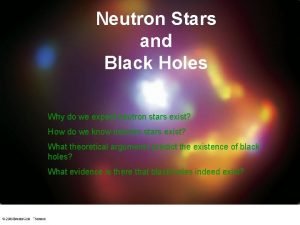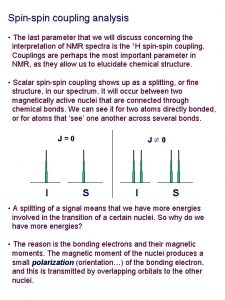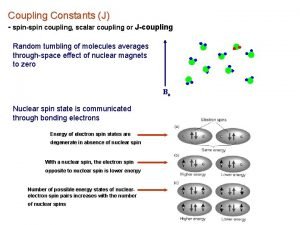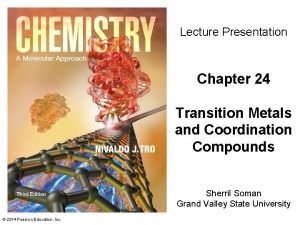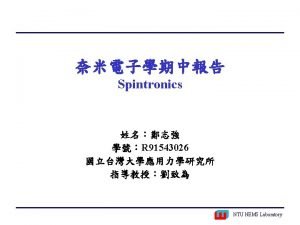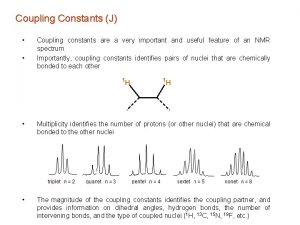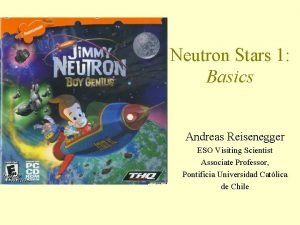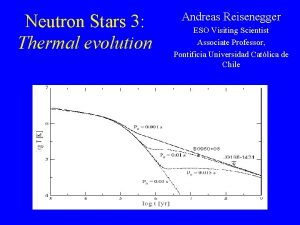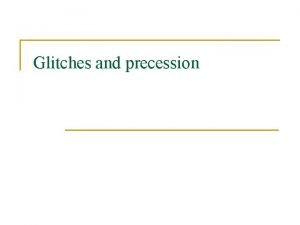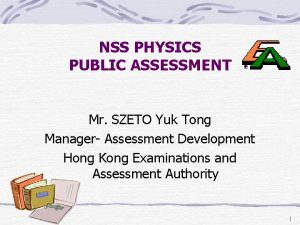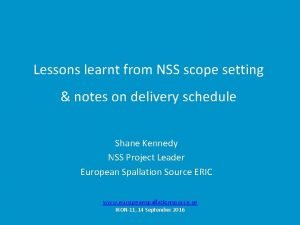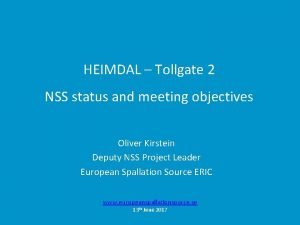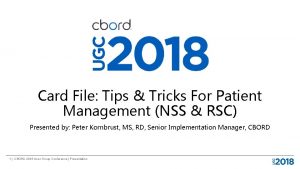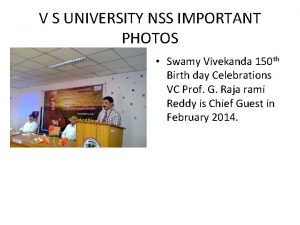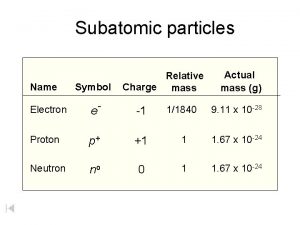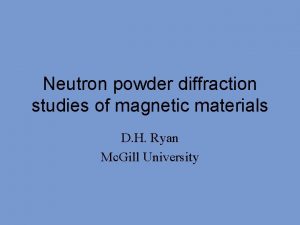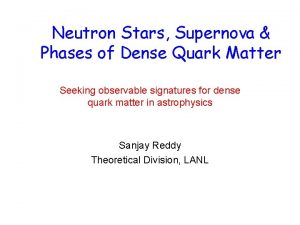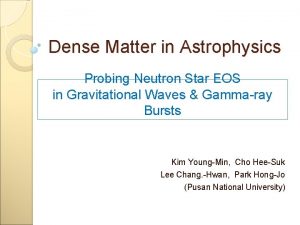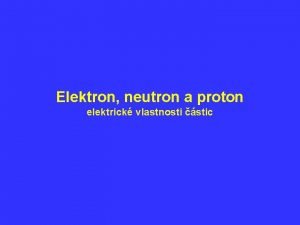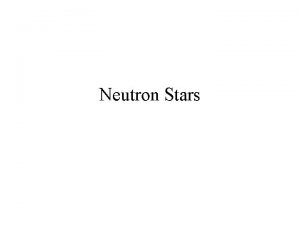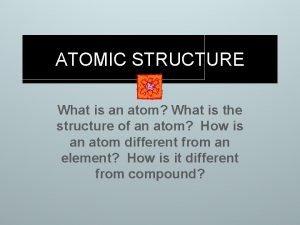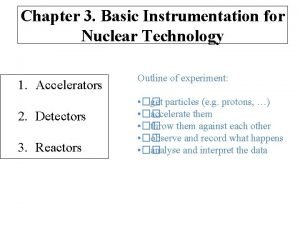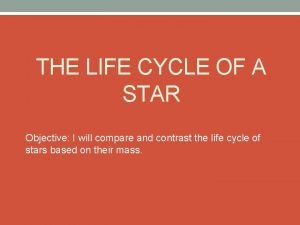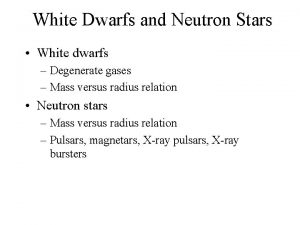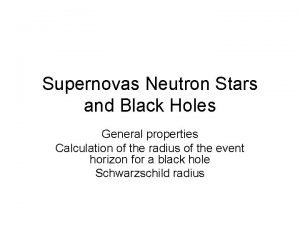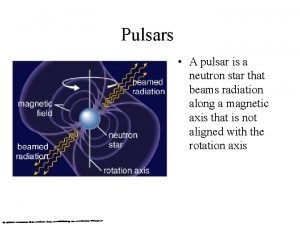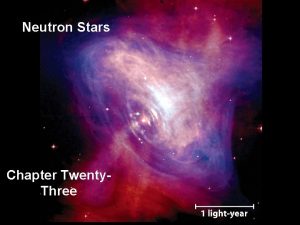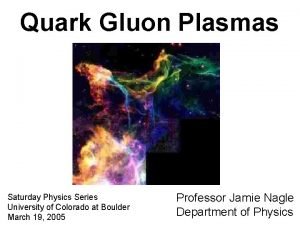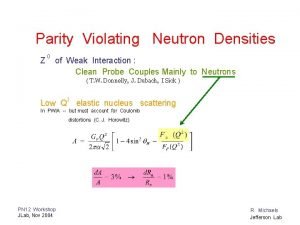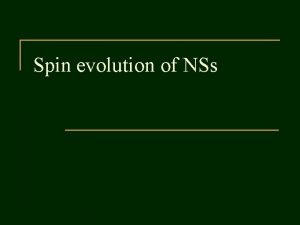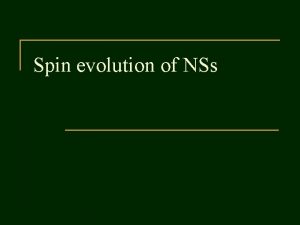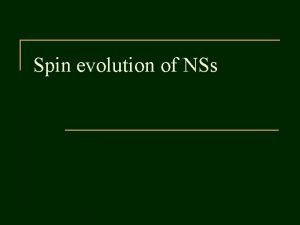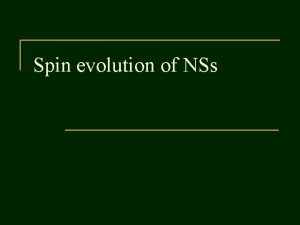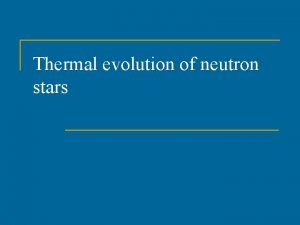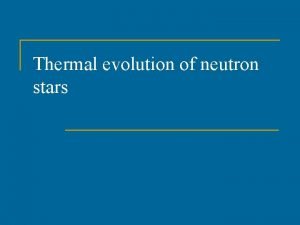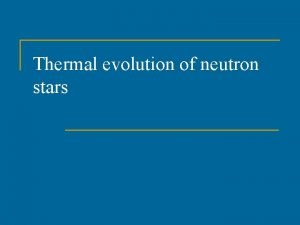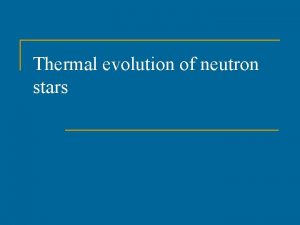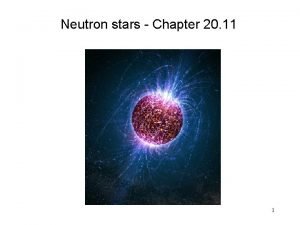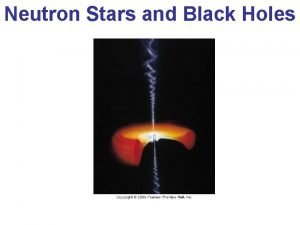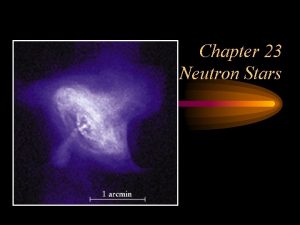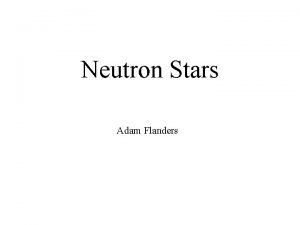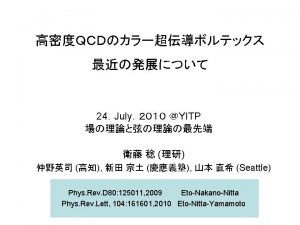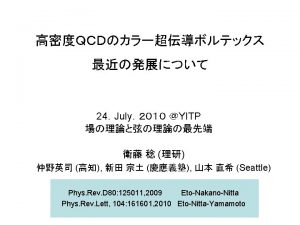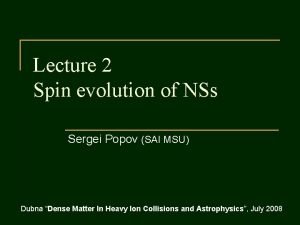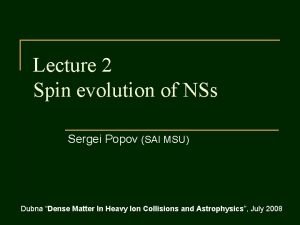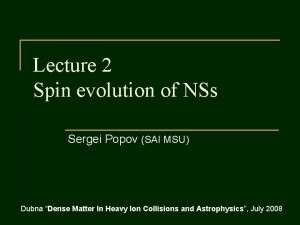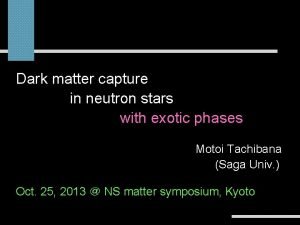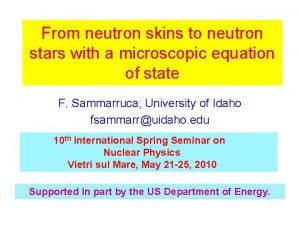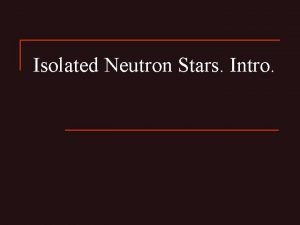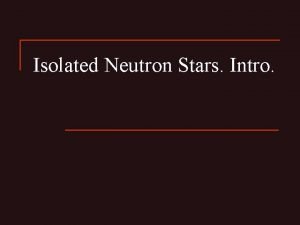Spin evolution of NSs Evolution of neutron stars












































- Slides: 44

Spin evolution of NSs

Evolution of neutron stars Thermal Magnetorotational Observational appearence of a NS can depend on: • Temperature • Period • Magnetic field • Velocity 2

Evolution of NSs: temperature Neutrino cooling stage Photon cooling stage First papers on thermal evolution appeared already in early 60 s, i. e. before the discovery of radio pulsars. [Yakovlev et al. (1999) Physics Uspekhi] 3

Evolution of neutron stars: rotation + magnetic field Ejector → Propeller → Accretor → Georotator 1 – spin down 2 – passage through a molecular cloud 3 – magnetic field decay Mdot/μ 2 astro-ph/0101031 See the book by Lipunov (1987, 1992) 4

Magnetic rotator Observational appearances of NSs (if we are not speaking about cooling) are mainly determined by P, Pdot, V, B, (and, probably, by the inclination angle χ), and properties of the surrounding medium. B is not evolving significantly in most cases, so it is important to discuss spin evolution. Together with changes in B (and χ) one can speak about magneto-rotational evolution We are going to discuss the main stages of this evolution, namely: Ejector, Propeller, Accretor, and Georotator following the classification by Lipunov 5

Magneto-rotational evolution of radio pulsars For radio pulsar magneto-rotational evolution is usually illustrated in the P-Pdot diagram. However, we are interested also in the evolution after this stage. Spin-down. Rotational energy is released. The exact mechanism is still unknown. 6

Fields in binaries: cyclotron line Now 36 X-ray pulsars in binaries. 1812. 03461 7

Radio pulsar braking: current The model of pulsar emission is not known, and also the model for spin-down is losses not known, too. Well-known magneto-dipole formula is just a kind of approximation. One of models is the longitudinal current losses model (Beskin et al. see astro-ph/0701261) Longitudinal current losses Magneto-dipole Both models predict evolution of the angle between spin and magnetic axis. Surprisingly, both are wrong! t 1/2 P P t 14/13 P 0/cosc 0 P/sinc 0 P 0 t Models of spin-down are not certain up to now, see 1903. 01528 t 8

Radio pulsar braking: braking index Braking index (definition) Magneto-dipole formula Longitudinal current losses For well-measured braking indices n<3. However, for many pulsars they are very large. This can be simply an observational effect (microglitches, noise, etc. ), but it can also be something real. For example, related to the magnetic field evolution. 9

Crab pulsar and angle evolution It seems that the angle is changing with the rate 0. 6 degrees per century. It is visible as the separation between the main pulse and interpulse is changing. The axis of the dipolar magnetic field is moving towards the equator. 1311. 0408 10

Pulsar emission The TPC model for w=0. 05 is shown in green, the OG model for w=0. 1 is shown in red and the PC emission site is shown in blue. The cyan lines show the locus of the possible high altitude (r=500 km, here for P=0. 2 s) radio emission, with the radiating front half shown solid and the back half dashed. Plotted for magnetic inclination 65 degrees. 0812. 3931 11

Peaks separation for different Increasing of magnetic inclination results in growth of the separation up to 180 parameters 0812. 3931 o 12

Theoretical studies of the angle evolution The authors studied the case of plasma filled magnetosphere. The angle should evolve towards zero. 1311. 1513 13

Initial tilt angle distribution The distribution of pulsar tilt angles is not consistent with a random distribution at birth. Deficit of PSRs with intermediate angles. Bimodality of initial angles? Viscous damping of precession results in the angle evolution for an oblique rorator. B B Toroidal field. Prolate. The angle evolves towards 90 degrees. Poloidal field. Oblate. The angle evolves towards alignment (i) the NS has a non-spherical shape which is mostly determined by magnetic stresses, (ii) the internal magnetic field is dominated by a toroidal component, thus - prolate deformation, (iii) at birth, the magnetic axis has a small tilt angle. 1708. 08925, see more recent calculations in 1910. 14336 14

Angle evolution Precession, viscous dissipation, electromagnetic radiation reaction. colour - time to reach the final state (in log sec) The dominant field is toroidal. ortogonalize align 1807. 01289, see more recent calculations in 1910. 14336 15

Magneto-rotational evolution of NSs Ejector → Propeller → Accretor → Georotator Mdot μ 2 See the book by Lipunov (1987, 1992) astro-ph/0101031 1 – spin down 2 – passage through a molecular cloud 3 – magnetic field decay 16

Critical radii -I Transitions between different evolutionary stages can be treated in terms of critical radii • Ejector stage. Radius of the light cylinder. Rl=c/ω. Shvartsman radius. Rsh. • Propeller stage. Corotation radius. Rco • Accretor stage. Magnetospheric (Alfven) radius. RA • Georotator stage. Magnetospheric (Alfven) radius. RA As observational appearence is related to interaction with the surrounding medium the radius of gravitational capture is always important. RG=2 GM/V 2. 17

Critical radii-II 1. Shvartsman radius It is determined by relativistic particles wind 2. Corotation radius 3. Alfven radius 18

Pressure For super. Edd accretion We can define a stopping radius Rst, at which external and internal pressures are equal. The stage is determined by relation of this radius to other critial radii. 19

Classification 20

Alfven radius in different Simple estimate of R presented before is just a zero approximation. situations Many different variants for different accretion regimes were obtained. A In particular, RA is modified in the case of disc accretion, and for low accretion rates. 1806. 11516 In the plot the radius in the case of disc accretion according to GL 79 is compared for different accretion rate and inclination with the model originally developed by Wang (1997). 21

R=Rco cos -2/3θ Rco=(GM/ω2)1/3 Light cylinder Rl=ω/c Ejector Propeller 22

Accretor Georotator 23

Critical periods for isolated NSs Transition from Ejector to Propeller (supersonic) Duration of the ejector stage Transition from supersonic Propeller to subsonic Propeller or Accretor A kind of equilibrium period for the case of accretion from turbulent medium Condition for the Georotator formation (instead of Propeller or Accretor) (see, for example, astro-ph/9910114) 24

Spin-up/down at the stage of accretion For a single rotator (i. e. an isolated NS) spin-up can be possible due to turbulence in the interstellar medium. In the case of isolated accreting NS one can estimate the accretion rate as: 25

Unified approach to spin-down One can find it comfortable to represent the spin-down moment by such a formula kt and Rt are different for different stages. kt can be also frequency dependent. 26

Equilibrium period The hypothesis of equilibrium can be used to determine properties of a NS. The corotation radius is decreasing as a NS is spinning up. So, before equilibrium is reached the transition to the propeller stage can happen. Looking at this formula (and remembering that for Accretors Rt=Rco) it is easy to understand why millisecond PSRs have small magnetic field. Spin-up can not be very large (Eddington rate). So, to have small spin periods (and so small corotation radii), it is necessary to have small magnetic fields. High magnetic field NS can not be spun-up to millisecond periods. 27

Accreting isolated neutron stars Why are they so important? • Can show us how old NSs look like 1. Magnetic field decay 2. Spin evolution • • Physics of accretion at low rates NS velocity distribution New probe of NS surface and interiors ISM probe 28

Expected properties 1. Accretion rate An upper limit can be given by the Bondi formula: Mdot = π RG 2 ρ v, RG ~ v-2 Mdot = 10 11 g/s (v/10 km/s) -3 n L=0. 1 Mdot c 2 ~ 1031 erg/s However, accretion can be smaller due to the influence of a magnetosphere of a NS 2. Periods of old accreting NSs are uncertain, because we do not know evolution well enough. a) RA=Rco 29

Subsonic propeller Even after Rco>RA accretion can be inhibited. This have been noted already in the pioneer papers by Davies et al. Due to rapid (however, subsonic) rotation a hot envelope is formed around the magnetosphere. So, a new critical period appear. (Ikhsanov astro-ph/0310076) If this stage is realized (inefficient cooling) then • accretion starts later • accretors have longer periods 30

Initial spin periods Determination of initial spin periods is closely linked with models of magneto-rotational evolution of neutron stars. Among thousands of known NSs just for a few tens there are estimates of initial spin periods. Just for a few such estimates a robust enough. Typically, it is necessary to have a independent estimate of a NS age. Then, using some model of magneto-rotational evolution the initial spin period is reconstructed. Independent ages: - SNR - Kinematic - Cooling 31

Sample of NSs+SNRs 30 pairs: PSR+SNR Popov, Turolla ar. Xiv: 1204. 0632 32

33

B vs. P 0 All presented estimates are made for standard assumptions: n=const=3. So, field is assumed to be constant, as well as the angle between spin and magnetic axis. Crosses – PSRs in SNRs (or PWN) with ages just consistent with spin-down ages. We assume that P 0<0. 1 P 1204. 0632 34

Checking gaussian The data we have is not enough to derive the shape of the P 0 distribution. However, we can exclude very wide and very narrow distributions, and also we can check if some specific distributions are compatible with our results. Here we present a test for a gaussian distribution, which fits the data. Still, we believe that the fine tuning is premature with such data. P 0=0. 1 s; σ=0. 1 s 35

Checking flat distrbution Flat between 0. 001 and 0. 5 s. Very wide distributions in general do not fit the data we have. 36

Theoretical calculations Typical initial periods of NSs are predicted to be ~100 -200 ms. Most rapidly rotating are expected to have ~50 ms. Initial rotational velocities 1907. 03713 37

Wide initial spin period distribution Based on kinematic ages. Mean age – few million years. Note, that in Popov & Turolla (2012) only NSs in SNRs were used, i. e. the sample is much younger! Can it explain the difference? 1301. 1265 38

Magnetic field decay and P 0 One can suspect that magnetic field decay can influence the reconstruction of the initial spin period distribution. Exponential field decay with τ=5 Myrs. <P 0>=0. 3 s, σP=0. 15 s; <log B 0/[G]>=12. 65, σB=0. 55 τ<107 yrs, 105<t<107 yrs Igoshev, Popov 2013 39

Real vs. reconstructed P 0 How much the reconstructed initial periods are changed due to not taking into account the exponential field decay? Igoshev, Popov 2013 40

Complications for magneto-rotational evolution 1. Internal structure can be important. For example, neutron vorticies can pin magnetic flux tubes (1106. 5997). Estimates indicate that this can be important for magnetars. 2. In young NSs a core can rotates faster than the crust (1210. 5872). 3. Non-trivial topology of the magnetosphere can be important. In magnetars a twisted magnetosphere can result in a different spin-down rate (1201. 3635, and see the lecture on magnetars) 4. Magnetic field can have a very non-trial evolution (see the next lecture) 5. Initial spin-periods can depend on additional phenomenae. Gravitational wave emission (1302. 2649 ). Neutrino emission (1301. 7495). Different instabilities (1110. 3937). 41

Conclusions • We have some framework for spin evolution of NSs. They are expected to pass several well-defined stages: Ejector (including radio pulsar), Propeller (probably, with subsonic substage), Accretor. NSs with large velocities (or fields) after the Ejector stage can appear as Georotators. • In binaries we observe Ejectors, Propellers and Accretor. For isolated NSs – only Ejectors (even, mostly radiopulsars). • There are still many uncertainties related to the spin evolution: 1. 2. 3. 4. Spin-down rate and angle evolution for radio pulsars Subsonic propeller stage for isolated NSs Inhibition of accretion at low rates The role of the field decay 42

Conclusions-2 • Observations of isolated accreting NSs can help a lot to understand all unknown questions of NS spin evolution and low-rate accretion. • Magnetic field decay can be important also for young NSs, especially for highly magnetized ones, as a source of energy. So, we have some coherent picture. . . But. . . A lot of funny thing a still waitng for us! 43

Papers and books to read • Lipunov V. M. “Astrophysics of neutron stars” (1992) • Lipunov, Postnov, Prokhorov “The Scenario Machine: Binary Star Population Synthesis” Astrophysics and Space Science Reviews (1996) http: //xray. sai. msu. ru/~mystery/articles/review/ • Boldin, Popov ``Evolution of isolated neutron stars till accretion’’ 1004. 4805 44
 How neutron stars form
How neutron stars form Spin spin coupling
Spin spin coupling Spin spin coupling
Spin spin coupling Low spin and high spin complex
Low spin and high spin complex Spin down
Spin down Geminal coupling
Geminal coupling Mary daniels is a student in england
Mary daniels is a student in england Narcistisch slachtoffer syndroom symptomen
Narcistisch slachtoffer syndroom symptomen Nss chemistry
Nss chemistry Nss slp
Nss slp Nss eso
Nss eso Nss frozen food
Nss frozen food Nss iit delhi
Nss iit delhi Remote network security services
Remote network security services Chem 4 kids.com
Chem 4 kids.com Andreas reisenegger
Andreas reisenegger Nss glitch
Nss glitch Nss physics
Nss physics Nss i
Nss i Nss scope
Nss scope Nss status
Nss status Cbord room service choice
Cbord room service choice Swamy associates bangalore
Swamy associates bangalore Api nbu
Api nbu Yutund
Yutund Business accounting and financial studies
Business accounting and financial studies Neutron particle symbol
Neutron particle symbol Magnets for neutron diffraction
Magnets for neutron diffraction Act 3 scene 2 macbeth summary
Act 3 scene 2 macbeth summary Neutron star
Neutron star Neutron star
Neutron star Periodic table protons neutrons electrons
Periodic table protons neutrons electrons Elektron neutron proton
Elektron neutron proton Neutron 1932
Neutron 1932 Mass of neutron
Mass of neutron Neutron life cycle
Neutron life cycle White dwarf neutron star black hole
White dwarf neutron star black hole Neutron superhighway
Neutron superhighway Crab nebula neutron star
Crab nebula neutron star Escape velocity neutron star
Escape velocity neutron star Tychos snr
Tychos snr Neutron star
Neutron star Proton neutron quarks
Proton neutron quarks Proton neutron quarks
Proton neutron quarks Parity of neutron
Parity of neutron
